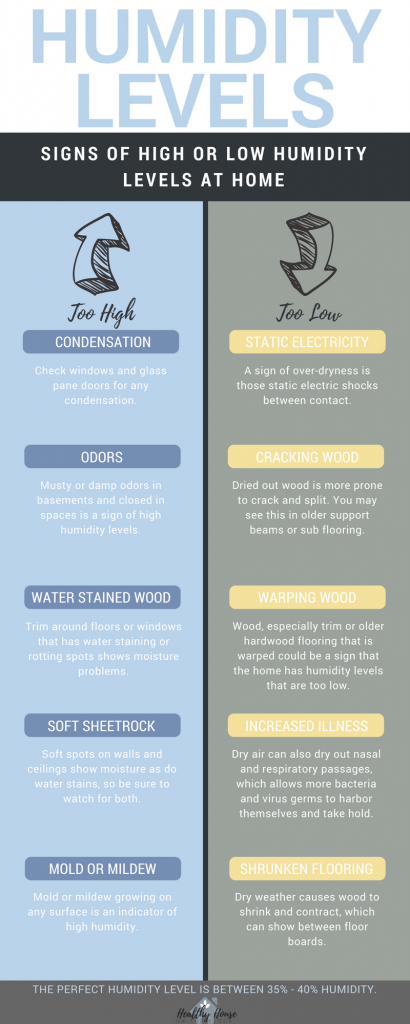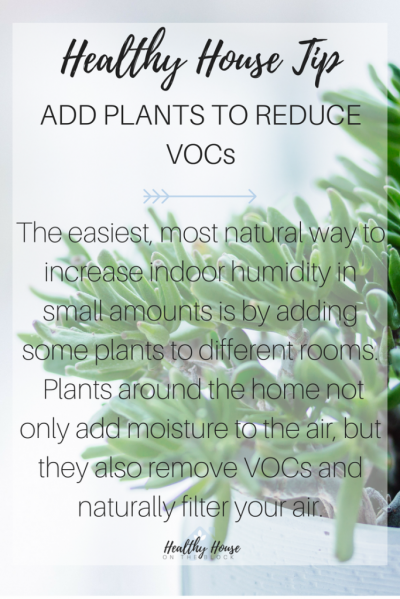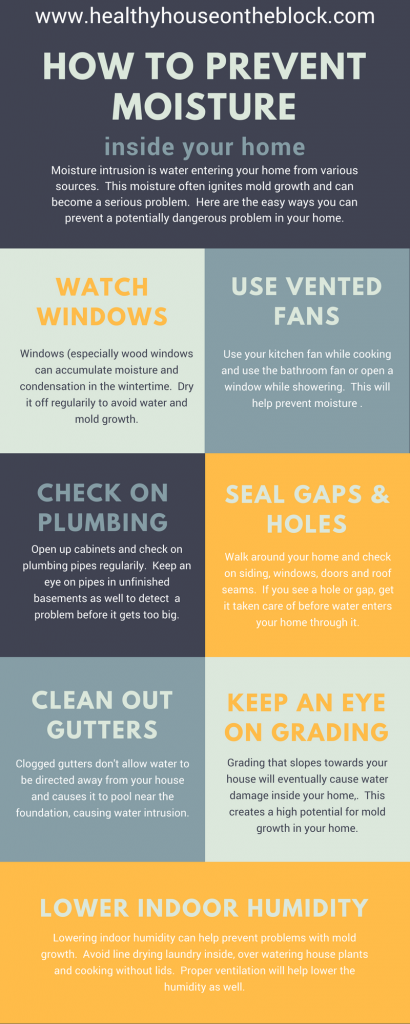
Humidity levels within a house can affect many different aspects of our home and lives, yet often times we pay little attention to what the ideal home humidity levels are. Whether you live in a dry or humid climate, the indoor climate of your home can have a huge impact on the health of your home and ultimately the health of your family. Not only do they affect the general comfort of those at home, but the amount of moisture in the air affects biological contaminants in a home like mold, mildew and dust mites.
Indoor humidity is the measure of moisture within your indoor air. Most homes will have excessively high humidity levels without the homeowners even being aware. There are many ways to tell if you have high or low humidity indoors, but the best way is to use a hygrometer or indoor air quality monitor.
FREE MUST HAVE TOOLS TO CREATE THE PERFECT INDOOR HUMIDITY
The best tools and habits to find and maintain the perfect humidity levels.
FREE INSTANT DOWNLOAD

IDEAL HOME HUMIDITY LEVELS
So what exactly is the ideal home humidity level for your house? In a perfect world it would be 35% humidity. But a general rule of thumb is somewhere between 35% – 40% humidity. Anything lower and you’ll feel incredibly uncomfortable; and any higher, you’ll increase your chances of mold growth, dust mites and other problems.
A study was done in Europe by a home health practitioner who concluded that if humidity levels were kept around 35%, you would see a drastic reduction of illness and allergies. This theory is based on the fact that dust mites and mold cannot survive in these conditions, which are a large contributor to viral illness and allergies.
HIGH HUMIDITY
If you find your home has a higher humidity level than you’d like, there are some easy ways you can reduce the levels. You can even tell if there’s extra moisture in the air without using a hygrometer or an indoor air quality monitor. (however these two tools are extremely helpful and much more reliable).
Some telltale signs that your home has higher humidity than it should:
- Condensation on windows and doors
- Musty odors (especially in basements)
- Water spots or water damage
- Soft spots in sheetrock or plaster walls
- Rotting or water stained wood
- Mold or mildew spots on walls or floors
- Moisture on foundation walls
If you notice any of these problems consistently or on a seasonal basis, it could be safe to assume you have higher than preferred humidity levels in your home.
VENTED FANS
The great news is, there are some really easy, inexpensive ways that you can reduce humidity levels in your home. Many things that will help are simple changes to your daily habits. One great way to reduce moisture in your home is by using your vented fans. Many bathrooms, kitchens and laundry rooms are equipped with a fan that has a vent attached to it running outside. These fans pull moisture out of the air and then push the air to the exterior of your home. Many times these fans go through the roof, but sometimes they vent outside through siding.
These fans are usually in rooms where moisture is the highest. Laundry, bathing and cooking often produce the highest amounts of moisture around a home and pulling the moisture out of these rooms is crucial to the health of your house.
A great tip is to check the vents every year or so to make sure the vent is connected and running out of your house rather than leaving excess moisture in your attic as it’s vented out of the room.
PLANTS
Another way you can help reduce moisture indoors is by making sure plants are not over watered. Believe it or not, plants add a lot of moisture to homes. While I’m a huge proponent of utilizing plants indoors, I also caution homeowners against having too many plants. If you’re prone to over water plants, it’s a good idea to have just a few spread throughout the home in order to prevent excess moisture in one area. Adding plants to an already humid room is also something that should be avoided.
LAUNDRY
Line drying laundry inside is yet another way that moisture can become too high. If you line dry indoors, you might use a basement space, which is humid to begin with as it’s underground. This scenario can increase humidity by 20% in an enclosed area while the laundry is drying. Using outdoor lines or utilizing fans and open windows while drying is ideal and a great way to reduce the indoor humidity in your house.
MOISTURE INTRUSION
Finally, if it’s a room that has plumbing through it or you have radiators that heat your home, make sure you don’t have a leak of some kind. Leaks add moisture and humidity into the air over time and when they’re inside a wall or ceiling, it can take a long time before they’re detected.
If there’s attic space above the room, you may also want to check that your roof is free from any leaks. A small leak or ice dam can add a lot of moisture to the attic, which then creates a moisture rich ceiling in the room below.
The basement and crawl space is yet another area to check to determine if there is water or moisture leaking in. Things that oftentimes cause moisture intrusion around the basement or foundation wall are:
- Sprinklers pointing at siding or foundation walls
- Over watering lawns and gardens next to the home
- Negative grading or soil sloping towards home rather than away
- Lack of gutters
- No moisture barrier between house and outdoor landscaping
- Lack of drain tile or damaged drain tile

Prevent Moisture
If you’ve checked your daily habits and tweaked them but still have high indoor humidity, there are still other options you can try in terms of lowering the humidity levels.
First and foremost, make sure the room in question has ample ventilation. This means using fans, opening vents and unblocking any cold air returns. The more air that can flow through the room, the less moisture will stick around.
Second, as mentioned before, using vented fans during activities that produce a lot of moisture will also help. Things like cooking, bathing and doing laundry are on the top of the list. You can also open a window if the air outside is less humid to have a similar effect.
Next you’ll want to check the exterior of your house. Are there trees and vegetation right next to the home? Is the home extremely shaded on all sides by shrubs and trees? These are ways that plants, gardens and trees help keep moisture high near and around our homes. Some greenery is wonderful, but too much can quickly mean moisture problems around foundation walls.
You’ll also want to check around windows, doors, and any vent that protrudes through your siding or roof to make sure there’s no air leaking in around it. In the summer, these leaks mean hot, humid air is entering the home more through the small areas surrounding a break in the siding. You can fill in around windows, doors and exhaust vents with an energy efficient caulk to prevent air from leaking in.
Finally go through your home with a fine tooth comb and check for water intrusion, or any sort of water leak. This could mean from pipes, in bathrooms and at fixtures in bathrooms, laundry rooms, utility rooms and kitchens. But it could also mean check for water intrusion around the foundation walls, near sump pump pits, in attics and around vents that exit through the home’s roof or siding.
If you still have a problem with high humidity indoors, the final step is to invest in a dehumidifier. Whether it be a single unit you can move around from room to room, or one built right into your furnace, this system will help bring the moisture out of the air and lower the humidity. Remember, a humidity level right around 35% is ideal.
HOW TO TELL IF YOUR AIR IS TOO DRY
Humidity levels go both ways, and during some seasons and in some parts of the world, the air is incredibly dry. This is anything below 30%. Often times the air outside itself is not quite this dry, but our habits at home like excessive heating or excessive cooling can contribute to the dry, dry air. Dry air at home can often cause a plethora of discomforts to those living there. Very quickly, dry skin and chapped lips become a constant battle. Those with skin issues such as eczema will have an either tougher time when there is very little moisture in the indoor air.
Other issues you might see arise are an increase in respiratory discomfort and illness. Dry air dries out the lining in our nose and respiratory tract, which is our natural defense from viruses and bacteria. When it’s dried out and cracks, you’ll most likely get infections and colds more often. Dry air can also cause a lot of discomfort with a dry and itchy throat or even nose bleeds.
You may also notice more static electricity around your house, which is another good indicator that your home’s air is just too dry. Static electricity is a sign of over-dryness and very low moisture in the air itself. Your house materials will also be a tell-tale sign if you have low humidity at home. Look at things like paint and natural wood. If they appear to be dry, warping or cracking, this could be due to low humidity levels. For example, if a home has hardwood floors and they begin contracting and warping, it’s time to add some moisture to the air to stabilize the hardwood and prevent it from moving during climate and season changes.

HOW TO INCREASE INDOOR HUMIDITY LEVELS
While increasing the humidity level at home is not as common as decreasing the levels, it may need to be done during different seasons.
First, you’ll want to test your home levels and see exactly how dry the air is. You can do this with a hygrometer, indoor air monitor or even a smart thermostat such as Nest. ONce you know just how much you want to increase your indoor humidity, you can work through the list below.
The easiest, most natural way to increase indoor humidity in small amounts is by adding some plants to different rooms. Plants around the home not only add moisture to the air, but they also remove VOCs and naturally filter your air. I love using plants that have other uses as well, like aloe vera, lavender or cooking herbs. If you can find plants that like to be watered more frequently, this will also help in adding more moisture to the indoor air.
Some of the daily habits mentioned before, such as line drying clothing and cooking without lids are other great ways to increase moisture in the home. Letting dishes air dry after washing them can help as well.
If all else fails, you can purchase cool mist vaporizers for individual rooms or for bedrooms. This will help with some of those dry weather symptoms that can arise like itchy skin, cracked lips and dry sinuses. Some people also choose to get a whole house humidifier to run in the winter time. This can help create an even level throughout the whole house. You’ll just want to make sure that the levels of humidity don’t increase too much.
Keeping the indoor humidity between 35% – 40% is ideal for your personal comfort as well as the health of your home. Taking advantage of modern tools and monitors will help get you to this ideal percentage. Remember, that each season may require a slight change in strategy to either increase or decrease those levels. You can get my Must Have Tools for Perfect Indoor Humidity Levels below to help with each season.






Pingback: Preparing a House for the Winter Season: Non Toxic House Detox Plan - Healthy House on the Block
Pingback: Identify Toxic Materials: Avoiding Sick Building Syndrome
Pingback: Autumn and Fall Ideas for a Healing, Healthy Home -